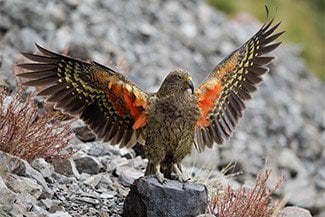Do parrots control probability?
 Keee-aa! This is the powerful call of the nestor kea or simply the “kea,” a species of mountain parrot (the only one in the world) that lives in New Zealand. This bird has recently surprised scientists by demonstrating its remarkable skills in the field of probability. Indeed, two researcher from the University of Auckland (New Zealand) have shed light on the kea's ability to make complex judgments based on statistical, physical, and social information.
Keee-aa! This is the powerful call of the nestor kea or simply the “kea,” a species of mountain parrot (the only one in the world) that lives in New Zealand. This bird has recently surprised scientists by demonstrating its remarkable skills in the field of probability. Indeed, two researcher from the University of Auckland (New Zealand) have shed light on the kea's ability to make complex judgments based on statistical, physical, and social information.Doctoral student Amalia Bastos and Professor Alex Taylor (the authors of the study) developed a three-part protocol to demonstrate that the parrots are able to draw logical inferences from the different types of information mentioned above: to detect what is known in mathematics as “the relative frequency of an object.” To understand how inference based on statistical probability works, let’s look at a simple example. Let’s say you love black olives. Suppose I put 10 in pot A and 10 in pot B. In the first, I add 50 green olives (which you like a lot less, especially since they’re not pitted!) And in the second I only add 5. I then shake the two pots and ask you to draw an olive from one without looking. Which pot will you choose? A or B? Obviously, you’ll choose B, since you've "calculated" that B contains the largest proportion or “relative frequency” of black olives.
To test this same reasoning ability in Blofeld, Bruce, Loki, Néo, Plancton, and Taz, keas from a reserve near Christchurch, scientists first trained them to associate a black token with a food reward, unlike orange tokens. Once the animals were “conditioned,” the scientists began the first experiment.
The experiment looked much like the olive example. The researchers filled two jars with black and orange tokens: one with more black tokens, and the other with more orange tokens. They showed the jars to the parrots. One of the researchers then rummaged through each jar to pick out a token, which they hid in their hand so that the kea could not see the color. The bird then had to tell which hand was most likely to hold the precious black token. After a number of trials, the keas systematically pointed their beaks to the hand that had drawn from the jar containing the most black tokens; the birds thus proved they were capable of using relative frequency to make their prediction.
In the second experiment (to test whether the keas could use information with a physical constraint in their predictions), the scientists made the task more complex. They presented the parrots with two jars that contained exactly the same proportion of black and orange tokens, but with a barrier placed inside, which caused the proportions to differ above and below. A band hid the lower half of the jar. In one of them, the proportion of black tokens was higher above the band. Again, the birds preferred this jar when choosing, as in the first experiment.
In the final experiment, the researchers tested the parrots’ ability to use social information in their predictions. Two experimenters each drew tokens from separate jars, but one of them (the “biased” experimenter) purposely drew black tokens from the jar where there were the least. The other (“unbiased”) experimenter drew tokens from the jar with the most black tokens without looking into the jar; he thus also drew black tokens. After observing these biased and unbiased samplings, the kea then saw the same two people take tokens from jars with identical proportions of black tokens. Which person did they systematically prefer? The birds chose the "biased" experimenter, temporarily forgetting the laws of relative probability!
The research protocol shows that parrots are indeed capable of considering statistical, physical, and social information. According to A. Bastos: “The results from the study are surprising as they mirror those from infants and chimpanzees in similar tests. […] This is the first evidence that a bird can make true statistical inferences and integrate different types of information into their predictions of uncertain events.”
Believe it or not, this study could influence artificial intelligence research. The authors suggest that a better understanding of the processes present in the avian brain could help create AI capable of making common sense judgments.
Source: Bastos, A.P.M., Taylor, A.H. “Kea show three signatures of domain-general statistical inference”, in Nature Communication, March 2020 // University of Auckland website: “Smarter than we thought: Kea reason about probability” - https://www.auckland.ac.nz/en/news/2020/03/04/smarter-than-we-thought--kea-reason-about-probability.html







